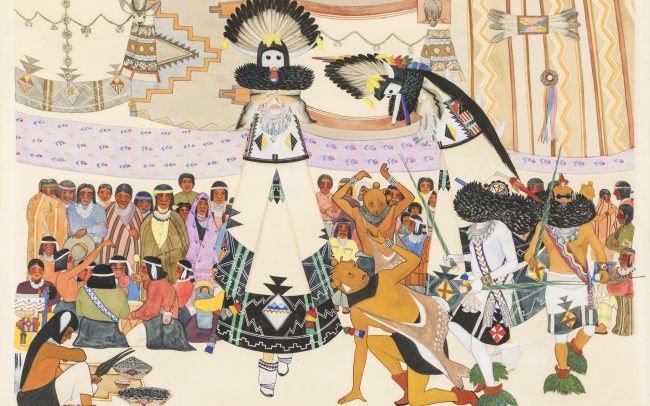Gallup New Deal Art

Currently, Gallup’s collection of New Deal architecture, Spanish Colonial-style tinwork, oak furniture, murals, prints, western American paintings, and Native art (156 objects in total) is housed in six different locations which are not all publicly accessible. Through a multi-faceted, interpretive, and highly interactive website, gallupARTS hopes to restore the legacy of the New Deal, unifying the collection, making it widely available as an unparalleled artistic and historical resource, and using it to promote community building.
In 2018, gallupARTS received a $30,000 Digital Projects for the Public “Discovery” grant from the National Endowment for the Humanities (NEH) to plan the Gallup New Deal Art Virtual Museum.
In 2020, it received a $100K Digital Projects for the Public “Prototyping” grant to continue developing the Gallup New Deal Art Virtual Museum by building and evaluating a prototype.
In 2023, gallupARTS is proud to announce it has received a $400K Digital Projects for the Public “Production” grant to build, launch, and distribute the Gallup New Deal Art Virtual Museum.
The forth-coming Gallup New Deal Art Virtual Museum will contain both scholarly information as well as creative content, being designed by experts in collaboration with Gallup’s artists and community members.
gallupARTS Executive Director Rose Eason is the Project Director.
INTERPRETIVE SPECIALISTS
- Dr. Molly Medakovich, Ph. D. – Teaching Specialist for the Denver Art Museum, Affiliate Faculty at the University of Denver School of Art and Art History, and Adjunct Faculty at the University of Colorado-Colorado Springs
- Robin Gavin – Curator Emerita of the Nuevo Mexicano Heritage Arts Museum (formerly the Museum of Spanish Colonial Art) and former curator of the Museum of International Folk Art
- Micaela Seidel, M.F.A & M.A. – Community arts educator, curator, writer and editor
- Madalena Salazar, M.A. – Freelance art historian, museum educator and grants administrator
- Rose Eason, Ed.M. – Arts and museum educator
EXPERT PEER REVIEW PANEL
- Ms. Allison Johnson, M.A. Candidate in Community and Regional Planning at the University of New Mexico and LOOM Gallery Co-Chair
- Dr. Kency Cornejo, Ph.D. – Assistant Professor of Modern/Contemporary Latin American Art History at UNM
- Winoka Yepa, M.A. – Institute of American Indian Arts Museum of Contemporary Native Art
- Kevin Brown, M.A. – Program Specialist for the Indigenous Nations Library Program at UNM
GENERAL ADVISERS
- Ms. Carol Sarath, M.L.S – Secretary of the gallupARTS Board of Directors and freelance researcher and writer
- Ms. Kathy Flynn, M.S. – Self-titled “New Deal Lead Detective” for New Mexico
- Ms. Carolyn Milligan, M.F.A. – This grant builds on the decade of work Ms. Milligan did to archive Gallup’s WPA collection and conserve and curate the County’s portion of the collection.
- Dr. Andrew Connors, Ph.D – Director of the Albuquerque Museum of Art and History
WEB DEVELOPERS
- Percent Invisible
- Kevin Wolf, Web Developer
- Kyle Gulau, Web Developer
- Media Tonic
- Danielle Reilly Weed, Web Project Manager
- Grey Dot
- Brett Johnson, Web Developer
DIGITAL MEDIA ADVISERS
-
Tammi Moe, M.I.L.S. – Director, Octavia Fellin Public Library
-
Suzanne Hammons – President of the gallupARTS Board of Directors and freelance web designer
The Gallup New Deal Art logo indicates the project’s goal to promote the historical value of Gallup’s New Deal art collection at the same time as advancing its contemporary significance. The image is an abstract take on the classic thunderbird, referencing the National Recovery Administration’s bald eagle logo and putting a Southwestern, modern spin on it.
In Summer 2024, gallupARTS is offering three FREE public tours of Gallup’s New Deal art collection.

Check out virtual tours and talks produced in conjunction with the Gallup New deal Art project.
(Click thumbnail images to view.)
Sample Gallup's New Deal Art collection:
The Gallup New Deal Art Project has been made possible iby
funding from the National Endowment for the Humanities.
Any views, findings, conclusions, or recommendations expressed in this project do not necessarily represent those of the National Endowment for the Humanities.













